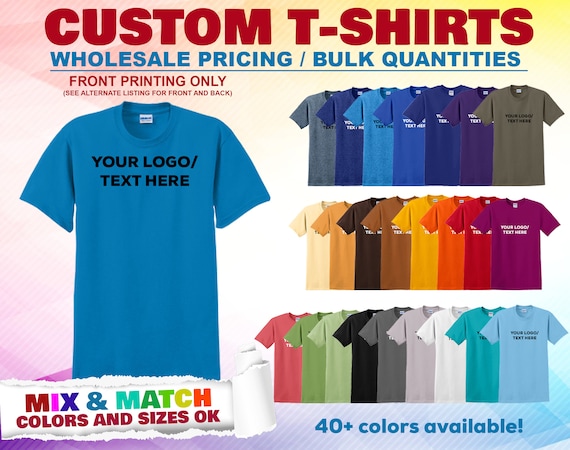Premium Screen Printing Kit for Business Startups
Premium Screen Printing Kit for Business Startups
Blog Article
Screen Printing Uncovered: Whatever You Required to Understand About T-Shirt and Garment Printing Methods
If you have actually ever wondered how those dynamic styles wind up on your preferred tee shirts, you remain in the ideal area. Display printing is a remarkable technique that integrates art with technique, providing endless opportunities for creativity. Understanding the principles, from equipment to ink selections, can greatly impact your results. All set to discover the crucial components that make display printing an art form? Allow's reveal the information that can elevate your projects.
The Fundamentals of Screen Printing: How It Functions
When you dive into display printing, you'll uncover it's both a science and an art. At its core, display printing entails creating a stencil, or display, that allows ink to pass with only in certain areas (screen printing kit). You start by selecting your design and preparing your display with a light-sensitive emulsion. As soon as you reveal this solution to light, it sets, leaving your style as a negative room.
Setting the screen over the fabric, after that use a squeegee to push ink with the display onto the garment. Each action is vital, and mastering them will elevate your display printing skills, changing basic garments into unique, expressive items.
Types of Screen Printing Strategies
Once you comprehend the essentials of display printing, it's time to explore the various methods that can elevate your layouts. One preferred method is typical display printing, where ink is pressed through a stenciled display.
If you're going for great information, take into consideration discharge printing. This method eliminates color from the fabric, leaving a soft, vintage look. Another option is plastisol printing, recognized for its longevity and vibrant colors, making it a favorite for numerous brands. Finally, try out halftone printing to produce slope effects and intricate designs. Each method has its special charm, so don't think twice to try them out to discover what fits your design best!
Crucial Tools for Display Printing
To attain sensational lead to display printing, having the right equipment is basic. You'll require a durable screen printing framework, which holds the mesh that transfers your style onto the garment. Next, buy premium squeegees; these are important for using ink evenly across the screen. You'll additionally need an excellent exposure device to develop your displays, along with a washout booth for cleansing them after usage. A reputable heat source, like a conveyor dryer or heat press, is crucial for curing your prints to assure durability. Do not fail to remember an appropriate workspace, outfitted with tables and storage for your materials. Ultimately, protective equipment, such as gloves and masks, will certainly keep you secure from chemicals and inks. With the right tools, you'll be well on your means to creating professional-quality prints.
Selecting the Right Inks and Products
When picking inks and materials for display printing, you need to consider the type of ink that works ideal for your project. Assume concerning textile compatibility to assure your styles look last and excellent long. Likewise, discover eco-friendly ink choices to make your printing procedure much more sustainable.
Sorts Of Display Inks
Selecting the best screen ink is essential for achieving dynamic, long lasting prints that fulfill your project's requirements. There are several kinds of screen inks to check out. Plastisol ink is popular for its convenience and convenience of usage, giving exceptional shade opacity on dark textiles. Water-based ink, on the other hand, offers a softer feel and is green, making it suitable for those aiming to decrease their environmental effect. Discharge inks eliminate color from the material, resulting in a soft, vintage look yet need specific handling. Specialty inks, such as metal or glow-in-the-dark, can include special effects to your layouts. Review your job demands and choose the ink that lines up finest with your desired outcome.

Fabric Compatibility Considerations
Comprehending material compatibility is important for accomplishing premium screen prints, particularly considering that various products respond uniquely to numerous inks. When selecting inks, take into consideration the textile kind-- cotton, polyester, or blends. For cotton, water-based inks work well, offering soft qualities and breathability. Polyester, on the various other hand, commonly needs plastisol inks for better adhesion and vivid shades. You could require to make use of a mix of both types if you're printing on blends. Always test your inks on sample material to assure they adhere properly and keep color integrity. In addition, remember that fabric weight and texture can influence the final result, so picking the right ink and product combo is crucial for your job's success.
Eco-Friendly Ink Options
Environmentally friendly inks are ending up being a prominent selection for display printers who intend to minimize their ecological effect while preserving top quality. When choosing inks, consider water-based inks, which are much less harmful and less complicated to tidy up contrasted to conventional solvents. These inks bond well with materials, supplying vibrant outcomes without hazardous chemicals. You might also explore eco-solvent inks that use fewer volatile organic substances (VOCs), making them a much safer choice for both your health and the planet.
In addition, try to find inks made from sustainable resources, such as soy or vegetable-based alternatives. By picking the right inks and products, you'll not only develop stunning styles but additionally add to an extra lasting printing procedure. Make the button, and your prints will certainly reflect your commitment to the environment!
Preparing Your Style for Display Printing

File Layout Demands
To guarantee your design looks lively and sharp on textile, you'll need to pay attention to submit layout requirements for screen printing. Begin with vector files like AI or EPS, as they can be scaled without shedding quality. If you use raster pictures, choose high-resolution files, such as TIFF or PNG, ideally at 300 DPI. Stay clear of using JPEGs, as they can lose quality when look at more info resized. Make certain your style has a transparent background to protect against undesirable white sides on your prints. Keep shade modes in mind; CMYK is basic for display printing, so transform your RGB designs as necessary - screen printing kit. By complying with these guidelines, you'll establish your art work up for a successful print.
Shade Splitting Up Strategies
Color splitting up is a crucial action in preparing your style for screen printing, and understanding it can substantially improve your print top quality. You'll require to damage your style into individual shades, as each shade needs a separate display throughout printing. Begin by determining all the colors in your design and produce layers each. You can make use of software program like Adobe Photoshop or Illustrator to isolate and separate colors successfully. Be particular to save each layer as a separate data, normally in a style like TIFF or PSD. This precision not only assures exact color representation but additionally streamlines the printing procedure. By focusing on shade separation, you'll achieve professional and dynamic cause your screen-printed garments.
Resolution and Size
Attaining the very best cause display printing begins with ensuring your style has the right resolution and size. Preferably, your art work needs to be at the very least 300 DPI (dots per inch) for sharp, clear prints. Your last product may look pixelated and amateur. if you make use of lower resolution.
When it involves size, take into consideration the dimensions of your print location. Layout your art work to match the final print size, ideally developing it in this page the real dimensions you'll be printing. By doing this, you'll avoid any type of unexpected scaling problems.
Constantly check your style in both vector and raster layouts. Vector graphics can be scaled without losing high quality, making them optimal for display printing. Preparing appropriately will guarantee your design looks incredible on every garment!
Step-by-Step Display Printing Process
Display printing is a dynamic process that allows you to create vivid layouts on numerous surface areas. To get started, you'll require a display, solution, and your selected ink.
Put ink onto the screen and utilize a squeegee to push the ink via the pattern onto the textile. Lift the screen thoroughly and allow the print completely dry. You have actually successfully display published your style.
Tips for Effective Display Printing Projects
While you're diving into your display printing projects, keep in mind that prep work is essential to success. Start by collecting all your products-- inks, screens, garments, and squeegees. A clean workspace aids avoid undesirable errors, so neat up before you begin.
Following, verify your art work is high-resolution and appropriately sized for your garment. Test your display for proper exposure and tidy it thoroughly to prevent spots. When mixing your inks, adhere to the producer's standards to achieve the appropriate consistency.
Throughout printing, use even stress with your squeegee for regular results. Don't rush; take your time to confirm each print meets your criteria. After printing, let your garments completely dry completely prior to handling or packaging them.
Finally, constantly maintain a sample of your help future referral. By doing this, you can examine your progression and improve your methods over time. Pleased printing!

Regularly Asked Inquiries
The length of time Does It Require To Establish a Display Printing Task?
Establishing a screen printing work generally takes around thirty minutes to an hour. You'll prepare the screens, mix inks, and adjust journalism. The moment differs based on intricacy and experience, so remain organized!
Can I Print on Various Material Types Using the Very Same Strategy?
Yes, you can print on different textile types using the very Learn More same strategy, but you'll require to adjust your settings and inks. Some materials absorb ink in different ways, so exploring guarantees the finest outcomes for each product.
What Prevail Errors to Avoid in Display Printing?
When screen printing, stay clear of typical mistakes like utilizing the incorrect ink, overlooking appropriate direct exposure times, or skipping pre-press checks. Always test your configuration and maintain tidy screens to assure quality outcomes each time.
How Can I Properly Clean and Keep My Screen Printing Tools?
To correctly tidy and maintain your display printing equipment, you must on a regular basis wash displays with appropriate solvents, inspect mops for wear, and guarantee all devices are stored dust-free and completely dry. Consistency enhances and protects against costly repair services efficiency.
Is Screen Printing Eco Friendly Compared to Other Approaches?
Screen printing can be much more eco-friendly than other approaches, especially if you utilize water-based inks and eco-conscious products. By selecting lasting supplies and techniques, you decrease waste and decrease your influence on the earth.
Screen Printing Uncovered: Everything You Required to Know Regarding Tee Shirt and Garment Printing Methods
At its core, screen printing involves creating a stencil, or screen, that permits ink to pass with only in specific locations. Setting the screen over the material, after that utilize a squeegee to push ink with the screen onto the garment. One prominent technique is typical screen printing, where ink is pressed through a stenciled screen.When picking inks and materials for screen printing, you require to take into account the kind of ink that works finest for your job.
Report this page